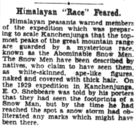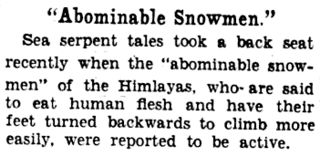Yeti
From Kook Science
(Redirected from Migoi)
| Yeti | |
|---|---|
| a.k.a. | Miche, mi-go, mirka, kang admi, Abominable Snowman |
| Origin | Tibet |
| Region(s) | Himalayan Mountains |
Yeti (from Tibetan: གཡའ་དྲེད་; g.ya'dred [pronounced: ya teh], "rock bear") is a crypto-hominid of the Himalayan region in Central Asia, sometimes also referred to as the Abominable Snowman (from an early newspaper report by Henry Newman). According to popular accounts, the creature is a human-like (or ape-like) creature of great size, covered with long hair, possessing a notably strong, distinctive odour.
Legends
The syncretic figure of the Abominable Snowman is drawn from the mythologies and accounts of the native Tibetan and Nepalese peoples, among others, including the Tibetan yeti, as well as the miche (from Tibetan: མི་དྲེད; mi dred, michê, "man-bear"), migoi or mi-go (from Tibetan: མི་རྒོད; mi rgod, migö/mirgö, "wild man"), bun manchi (from Nepali for "jungle man"), mirka (from Nepali for "wild man"), and kang admi ("snow man").
Reading
- Sanderson, Ivan T. (1961), Abominable Snowmen: Legend Come to Life: Story of Sub-humans on Five Continents from Early Ice Age to Today, UK: Gazelle
- Coleman, Loren (1989), Tom Slick and the Search for the Yeti, Boston: Faber & Faber
Resources
- Alpine Journal archives on the Yeti, alpinejournal.org.uk, 1999, 2001, http://www.alpinejournal.org.uk/Articles_by_Area/Article_Pages/HimYeti.html
Press Coverage
1920s
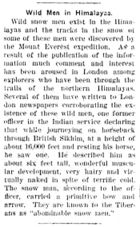
"Wild Men in Himalayas", Bennington Evening Banner (Bennington, VT), 1921-12-28
Wild snow men exist in the Himalayas and the tracks in the snow of some of these men were discovered by the Mount Everest expedition. As a result of the publication of the information much comment and interest has been aroused in London among explorers who have been through the trails of the northern Himalayas. Several of them have written to London newspapers corroborating the existence of these wild men, one former officer in the Indian service declaring that while journeying on horseback through British Sikhim, at a height of about 16,000 feet and resting his horse, he saw one. He described him as about six feet tall, wonderful muscular development, very hairy and virtually naked in spite of terrific cold. The snow man, according to the officer, carried a primitive bow and arrow. They are known to the Tiberans (sic) as "abominable snow men."
"HE SAW SNOWMAN", Greenbrier Independent (Lewisburg, WV), 1922-02-17
Englishman Corroborates Story Told by Explorers.
Probability That There is a Mysterious Race That Has Not Been Reached by Civilization.
17 Feb. 1922 -- William Hugh Knight, a member of the British Royal Societies Club, recently recalled to a representative of the London Times an occasion some years ago when he was able to inspect closely a figure which he believes to be that of one of the "Abominable Snowmen" to whom reference has been made by members of the Mt. Everest expedition. He said:
"Shortly before the last Tibetan war I was returning from Tibet with another European, A Tibetan Guide, and our train of about 40 or 50 coolies. We were coming down the track which leads from Gnatong to Sedonchen. We wanted to go to Gantok by the higher track, but Tenzin Wagdi, our guide, said the coolies would not face the leeches, so we had to take the lower track, which roughly follows the river. As we got near Gantok we had to climb the long ascent. My companion had gone on ahead with the coolies. I was about half a mile behind about half a mile below Gantok.
"I stopped to breathe my horse on an open clearing and dismounted, loosened the girths and watched the sun, which was just about setting. While I was musing I heard a slight sound, and, looking round, I saw, some 15 or 20 paces away, a figure which I now suppose must have been one of the hairy men that the Everest expedition talk about and the Tibetans, according to them, call the "Abominable Snowmen."
"Speaking to the best of my recollection, he was a little under six feet high, almost stark naked in that bitter cold — it was the month of November. He was a kind of pale yellow all over, about the color of a Chinaman, a shock of matted hair on his head, little hair on his face, highly splayed feet, and large formidable hands. His muscular development in the arms, thighs, legs, back and chest was terrific. He had in his hand what seemed to be some form of primitive bow. He did not see me, but stood there, and I watched him for some five or six minutes. He was watching some man or beast far down the hillside. At the end of some five minutes he started off at a run down the hill, and I was impressed with the tremendous speed at which he traveled.
"So far as I can remember, I mentioned the matter in the Gurkha mess that night, and to Claude White when I saw him at the residence next morning, but my recollection is that they took it rather as a matter of course. The incident more or less passed out of my mind until I read about the tracks in the snow written of by members of the Mt. Everest expedition."

"The Wild Man of Thibet", Bridgeport Times (Bridgeport, CN), 1922-02-24
24 Feb. 1922 -- WILLIAM HUGH KNIGHT, a member of the British Royal Societies Club, recently recalled to a representative of the London Times an occasion some years ago when he was able to inspect closely a figure which he believes to be that of one of the "Abominable Snowmen" to whom reference has been made by members of the Mt. Everest expedition. He said:
Shortly before the last Tibetan war I was returning from Tibet with another European, A Tibetan Guide, and our train of about 40 or 50 coolies. We were coming down the track which leads from Gnatong to Sedonchen. We wanted to go to Gantok by the higher track, but Tenzin Wagdi, our guide, said the coolies would not face the leeches, so we had to take the lower track, which roughly follows the river. As we got near Gantok we had to climb the long ascent. My companion had gone on ahead with the coolies. I was about half a mile behind about half a mile below Gantok.
I stopped to breathe my horse on an open clearing and dismounted, loosened the girths and watched the sun, which was just about setting. While I was musing I heard a slight sound, and, looking round, I saw, some 15 or 20 paces away, a figure which I now suppose must have been one of the hairy men that the Everest expedition talk about and the Tibetans, according to them, call the "Abominable Snowmen."
Speaking to the best of my recollection, he was a little under six feet high, almost stark naked in that bitter cold — it was the month of November. He was a kind of pale yellow all over, about the color of a Chinaman, a shock of matted hair on his head, little hair on his face, highly splayed feet, and large formidable hands. His muscular development in the arms, thighs, legs, back and chest was terrific. He had in his hand what seemed to be some form of primitive bow. He did not see me, but stood there, and I watched him for some five or six minutes. He was watching some man or beast far down the hillside. At the end of some five minutes he started off at a run down the hill, and I was impressed with the tremendous speed at which he traveled.
So far as I can remember, I mentioned the matter in the Gurkha mess that night, and to Claude White when I saw him at the residence next morning, but my recollection is that they took it rather as a matter of course. The incident more or less passed out of my mind until I read about the tracks in the snow written of by members of the Mt. Everest expedition.
1930s
"Himalayan ‘Race’ Feared", Evening Star (Washington, DC), 1930-06-29
Himalayan peasants warned members of the expedition which was preparing to scale Kanchenjunga that the top-most peaks of the great mountain range are guarded by a mysterious race, known as the Abominable Snow Men. The Snow Men have been described by natives, who claim to have seen them, as white-skinned, ape-like figures, naked and covered with thick hair. On the 1929 expedition in Kanchenjunga, E. O. Shebbeare was told by his porters that they had seen the footprints of a Snow Man, but by the time he had reached the spot a snow storm had obliterated any marks which might have been there.
"Abominable Snowmen", Evening Star (Washington, DC), 1937-09-16
Sea serpent tales took a back seat recently when the "abominable snowmen" of the Himalayas, who are said to eat human flesh and have their feet turned backwards to climb more easily, were reported to be active.
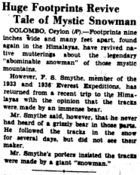
"Huge Footprints Revive Tale of Mystic Snowman", Evening Star (Washington, DC), 1938-02-13
COLOMBO, Ceylon (AP) — Footprints nine inches wide and many feet apart, found again in the Himalayas, have revived native mutterings about the legendary "abominable snowman" of those mystic mountains.
However, F. S. Smythe, member of 1933 and 1936 Everest Expeditions, has returned from a recent trip to the Himalayas with the opinion that the tracks were made by an immense bear.
Mr. Smythe said, however, that he never had heard of a grizzly bear in those parts. He followed the tracks in the snow for several days, but did not see their maker.
Mr. Smythe's porters insisted the tracks were made by a giant "snowman."
1950s
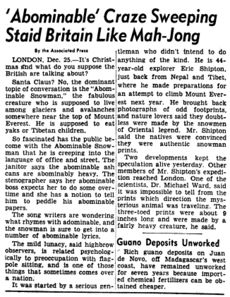
"‘Abominable’ Craze Sweeping Staid Britain Like Mah-Jong", Evening Star (Washington, DC), 1951-12-25
By the Associated Press
LONDON, Dec. 25. — It's Christmas and what do you suppose the British are talking about?
Santa Claus? No, the dominant topic of conversation is the "Abominable Snowman," the fabulous creature who is supposed to live among glaciers and avalanches somewhere near the top of Mount Everest. He is supposed to eat yaks or Tibetan children.
So fascinated has the public become with the Abominable Snowman that he is creeping into the language of office and street. The janitor says the abominable ash cans are abominably heavy. The stenographer says her abominable boss expects her to do some overtime and she has a notion to tell him to peddle his abominable papers.
The song writers are wondering what rhymes with adominable, and the snowman is sure to get into a number of abominable lyrics.
The mild lunacy, said highbrow observers, is related psychologically to preoccupation with flag-pole sitting, and is one of those things that sometimes comes over a nation.
It was started by a serious gentleman who didn't intend to do anything of the kind. He is 44-year-old explorer Eric Shipton, just back from Nepal and Tibet, where he made preparations for an attempt to climb Mount Everest next year. He brought back photographs of odd footprints, and nature lovers said they doubtless were made by the snowmen of Oriental legend. Mr. Shipton said the natives were convinced they were authentic snowman prints.
Two developments kept the speculation alive yesterday. Other members of Mr. Shipton's expedition reached London. One of the scientists, Dr. Michael Ward, said it was impossible to tell from the prints which direction the mysterious animal was traveling. The three-toed prints were about 9 inches long and were made by a fairly heavy creature, he said.
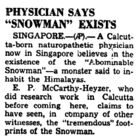
"Physician Says ‘Snowman’ Exists", Key West Citizen (Key West, FL), 1952-06-17
SINGAPORE. — (AP). — A Calcutta-born naturopathetic physician now in Singapore believes in the existence of the "Abominable Snowman" — a monster said to inhabit the Himalayas.
E. P. McCarthy-Heyzer, who did research work in Calcutta before coming here, claims to have seen, in company of other witnesses, the "tremendous" foot-prints of the Snowman.
The Mustang Raja's Yeti Hide, UPI (Kathmandu, Nepal), 1958
- UPI (14 Jun. 1958), "Human Feet; Nepal Hunters Slay Snowman", Desert Sun (Palm Springs, CA): 1, https://cdnc.ucr.edu/cgi-bin/cdnc?a=d&d=DS19580614.2.6&e=-------en--20--1--txt-txIN--------1
- UPI (17 Nov. 1958), "Mystery in Himalayas: Scientists Invited to Examine Skin That May Be Abominable Snowman", Albuquerque Journal (Albuquerque, NM): 7, https://www.newspapers.com/clip/119677047/mystery-in-himalayas-scientists/
- UPI (20 Nov. 1958), "Abominable Snowman Search Set; Trek Backed By American", Tucson Daily Citizen (Tucson, AZ): 34, https://www.newspapers.com/clip/119676987/abominable-snowman-search-set-trek/
Accounts of the Crypto-Hominid Research Council diverge from the more conventional narrative that follows, offering fresh perspective on the Yeti question.

